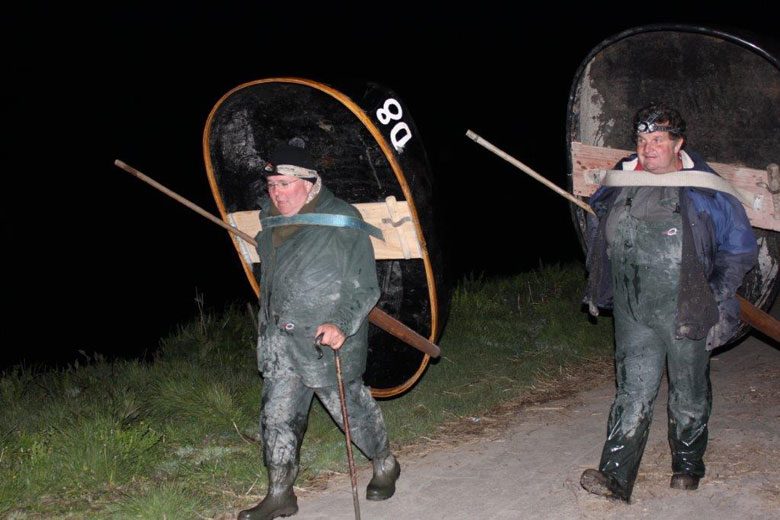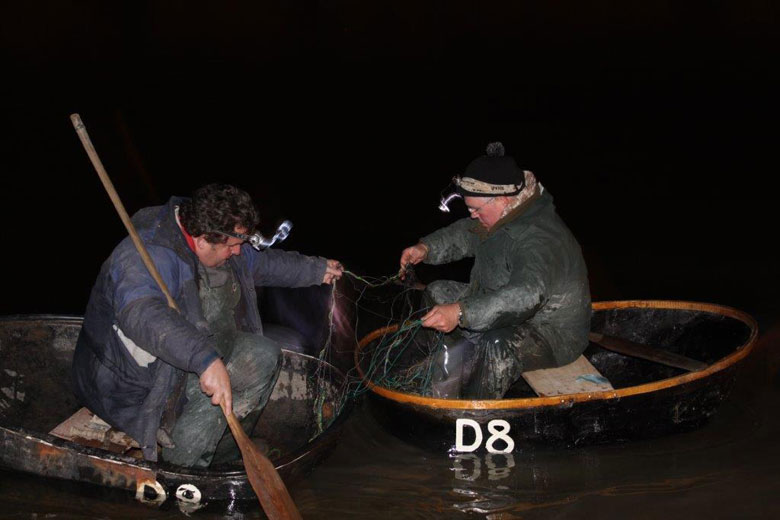Doing the rounds
Coracle fishing for sea trout and salmon on Welsh rivers is a tradition dating back hundreds of years, but only a handful of licences still exist today. Dai Francis sees the rare skill involved first hand on the River Towy in Carmarthen.
It’s been a slow start to the sea trout (sewin) season in Wales, but the quality of the fish we have seen at the Severn & Wye Smokery has been amazing, with some large specimen fish already landed. It’s not uncommon to see fish of 5kg plus but we have had one in that weighed over 9kg. We source our Welsh sea trout from the coracle fishermen who fish the River Towy town water in Carmarthen. Yoshi, the head chef at one of our customers, Umu restaurant in Mayfair, having received one of these large early fish was keen to know where it came from and intrigued when I explained the catch method. Of course seeing the men fishing in person is the only way to really understand the skill and difficulty involved, so a visit was planned.
Coracles are simple boats made of a woven wooden framework in the shape of a bowl, large enough for one man to sit in. Originally they were covered in skin, though nowaways a canvas or calico cloth is used, then waterproofed with a boiled mixture of tar and linseed oil. Coracle fishing dates back hundreds of years and is described in detail by Roman writers Caesar and Pliny. Suggestions have been made that the word coracle is derived from the Latin word corium meaning skin layer.
It wasn’t until the second half of the 18th century that coracle fishing became synonymous with rivers in South Wales. In the 1860s, according to a government commissioner’s report, no fewer than 400 men were supporting themselves on the River Towy’s salmon and sea trout fisheries. It was the Salmon and Freshwater Fisheries Act 1923 that more or less put an end to coracle fishing on many of the Welsh rivers such as the Severn, Usk and the Dee, and restricted the number of licences on the tidal stretches of the rivers Towy, Taf and Teifi.
Today less than 10 licences still exist. Each licence basically allows a pair of manned coracles to hold in one hand a net of roughly 11 yards in width between the two coracles, and with their other hand steer the coracle with a paddle as they are swept in tandem downstream with the flow of the river. The degree of difficulty is all compounded by the fact that they fish only at night. When they feel a fish hit the back of the net they gather in the net and get the fish into one of the coracles and then reset the net while still careering downstream on the flow of the river.
Yoshi and I agreed on a date. Food writer Joe Warwick, when hearing of our trip, asked if he could join us as he was in the area, and a plan was hatched. We rendezvoused in Bristol and set off for Carmarthen arriving just after midnight. When we met, fisherman Jonny Rees and fishing partner Dai looked a bit downhearted and explained conditions were poor and that two sets of coracle men had already gone home, plus they had already taken two swings down the river to no avail. It was what they called a drift tide (very slow), which meant that we would be able to stroll slowly down the parallel towpath as they fished, as opposed to the gentle jog needed to keep pace with a normal tide.
So that’s what we did. As they slowly drifted downstream Jonny shouted up to us on the bank “Look at the lampreys swimming towards the coracles; they’ve come to check on how mad we are.” We could just about make out their heads swimming snake-like as they broke the surface water to inspect the coracles invading their water. After drifting for three-quarters of a mile, Jonny and Dai exited the river, hoisting the coracles on to their backs to walk back up the towpath with us into town. Jonny explained that this definitely wasn’t a money-making exercise – they were preserving the rights of a heritage fishery.
It was Friday, and with coracle fishing banned at weekends it wouldn’t be until next week that we would see sea trout again. Yoshi was disappointed that we hadn’t caught a fish, and had been hoping to demonstrate to Jonny the ancient Japanese ikejime, a method of killing fish that improves the quality and delays the decomposition process. So we simply resolved that we would have to come again. When we arrived back at the town’s coracle storage shed two of the fishermen that had gone home earlier had decided, after a restorative cup of tea, to return and have another go. The temperature was now freezing and Jonny declared them desperate or mad. We decided the warmth of home beckoned, and true enough (I have it on good authority) no fish were caught that night.
Since our trip, wind and bad weather put paid to fishing for several days but fresh water and a bigger tide have improved conditions and Jonny is back catching fish again. Yoshi is now in Portugal teaching some day boat fishermen there the art of ikejime and Joe is making sure he’s got some warmer clothes for our next fishing trip.
Dai Francis is “Ambassador without Portfolio” at Severn & Wye Smokery, severnandwye.co.uk. You can follow him on Twitter at @gastroboar. This piece is the latest from his excellent Tales from the Riverbank newsletter: subscribe here.







